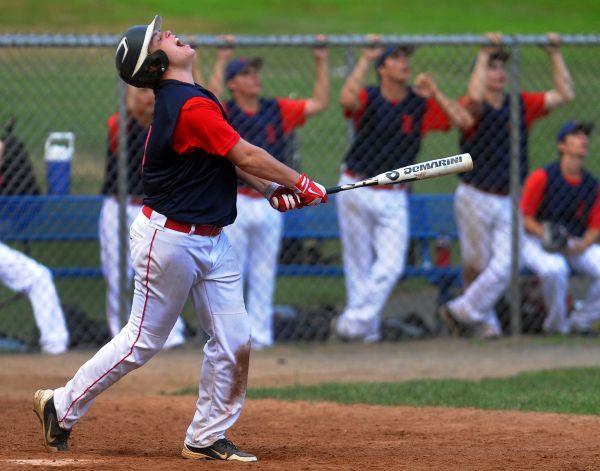08 Aug Two Inches: The Difference Between a Home Run and a Pop Fly (or A Wildly Successful News Release or A Dud)
Abraham, Stamford Advocate)
I love baseball. Always have, always will.
Sure, I love watching (and playing) other sports: football, volleyball, basketball, even soccer (especially after the 2014 World Cup).
But for me, there’s just something special about baseball (and its tamer cousin, softball).
Maybe it’s the fact that baseball is truly a summer sport where players can battle for hours, sun beating down on their backs, sweat trickling off their necks, and the dust of the base paths darkening their cleats as they round the bases. Or maybe it’s because there’s almost nothing better than chowing down a juicy kosher all-beef frank slathered with spicy mustard that’s caressed by the coolness of a frosty beverage on a sweltering day/night game while taunting opposing players from the comfort and safety of front row seats behind third base.
Be these baseball realities or not, I do know that I also love the game for the nuances that are often lost on those who are not students of the art that is known as baseball.
Take for example the importance of two inches when it comes to hitting either a pop fly or a home run.

Why Two Inches Matter
Two inches. That’s shorter than the length of the thumbs of most people.
And yet when it’s your turn at the plate, if your stance is off by a mere two inches, you will likely hit a pop-up instead of driving through the ball, let alone hitting a home run.
I remember learning this lesson several years ago during batting practice.
I spent ~20 years in my younger days playing slow-pitch softball. I was a pitcher/coach, and I had the ability back then to put the ball almost anywhere in and around the plate depending upon the batter and game situation. In the process, I learned a thing or two about batters as I faced thousands of ‘em while playing the game.
On this particular day, I was standing near the first base dugout taking in the practice. My teammate (who shall remain nameless), was up to bat, and I watched as over and over he hit fly ball after fly ball. And as he did so, I could see him become more and more frustrated as he struggled at the plate.
To be clear, he was a good hitter, someone with the skills and strength to hit with power, to drive the ball both deep and fair, and to any part of the field (should he choose to do so). But not this day. And as the pop flies continued, his frustration grew.
The frustration of flying out
Then all of a sudden it hit me.
It was as if I was watching his swing in super slo-mo, yet it was being played side-by-side in my mind next to a different mental image of him hitting the ball deep over the outfield fence.
“Hold on a second,” I yelled as I held up my hand to the pitcher and began trotting toward the batter’s box.
As I got close to my teammate I said, “Your swing is off,” and I held up my thumb and index finger for him to see with a gap between the two of about two inches. He looked at me sideways like I was a knucklehead—he knew his swing was off.
“No, seriously,” I added as I saddled up to him. “You’re dropping your back shoulder about this much.” And I held out my thumb and finger again for him to see the gap; it was roughly two inches wide.
“Huh?” he asked.
“Yeah,” I replied, and I mirrored his stance on the opposite side of the plate where lefthanders stood.
“This is what you normally do. You stand like this, leaning back on your back foot, with your left elbow in tight and your right elbow high, almost parallel to the ground. And when the pitch comes, you typically lean back and upwards first before stepping through the pitch. But not today.
“Today, you’re doing everything the same until the pitch is on the way. And then, instead of leaning back and up, you’re leaning back and down, like this.” And I showed him what his swing that day looked like.
“In other words, you’re dropping that back shoulder. That’s why you’re popping up. Keep your back shoulder up and you’ll be fine.”
And with that, I backed away from the plate and walked backward toward the dugout watching him.
He looked at me for a long couple of seconds, then dug back into the batter’s box, nodded at the pitcher, and then he proceeded to put the next pitch deep into left centerfield. And the next pitch and the pitch after that. And most of the remaining pitches he swung at that day.
Me? I just smiled.
Why Perfect Practice is What Really Matters
The old cliché suggests that “Practice makes perfect.”
But in reality, this saying has it all wrong—just ask my former teammate back on that summer morning. He was practicing, alright, but his practice was off, only by two inches, mind you. But it was off nevertheless.
And until he realized that was what he was doing (and in this instance, someone had to tell him), he could not hit perfectly. And that was a true problem.
In reality
“It is only through perfect practice that you can achieve perfection.”
David Politis, Marketer, Thinker, Author, Speaker & Advisor
I remember once being asked to serve as a judge for an awards competition in the Public Relations field. My task was to serve as one of several judges reviewing entries in the PR Campaign category.
What I found most interesting was the number of entries I found with misspelled words, bad grammar, incorrect punctuation and other mistakes. It was as if no one had taken the time to even review the entries before they were submitted for consideration. In other words, it was like they were dropping their back shoulder and they were off by a figurative “two inches.”
Conversely, there were several entries where everything was done properly: words were spelled correctly, they used good grammar, the punctuation was on pointe, etc.
In other words, they kept their proper posture throughout the entire swing which allowed them to achieve impressive results.
Applying the Two-Inch Rule to PR Writing
I’ve now been in the Public Relations and Marketing fields for more than three decades. During that time, I’ve seen a lot of writing—most of it okay, some of it awful, and a bit of it spectacular. Or said more correctly, some of it perfection.
When it comes to working with journalists, especially in today’s overworked and hypercompetitive newsrooms, I have found that most times, most reporters are so busy they are looking for reasons (or excuses) to not cover this company or that product or this topic.
And in my experience, mistakes—of any kind, in any PR or Marketing document or materials—generally prove to be the kiss of death for achieving the desired result.
For example, some of the mistakes I’ve seen recently in some news releases include
- Buried ledes,
- Poor sentence structure,
- Use of redundant or superfluous words,
- Misspelled words,
- Mismatched subject—verb combinations,
- Use of non-journalistic writing styles,
- Improper punctuation usage, and
- More.
To be sure, I am not suggesting I am a perfect writer. In fact, I’m still appalled that I once sent out a news release containing the phrase “pubic relations” instead of the proper term “public relations.”
“I once sent out a news release containing the phrase pubic relations instead of the proper term public relations.”
But I am a better writer than I used to be. And I now spend a lot more time
- Thinking about and evaluating my own writing, and
- Spell checking and proof-reading documents,
. . . Before they are approved and sent out the door.
Why? Because the little things do matter—a lot.
Just like the importance of two inches in baseball—it can literally mean the difference between a home run or a simple fly out.
# # #
Author’s note: This post was updated 04 August 2020.



No Comments